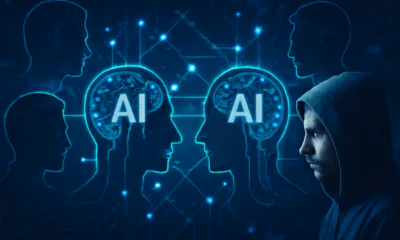Artificial Intelligence
The AI Feedback Loop: Maintaining Model Production Quality In The Age Of AI-Generated Content

Production-deployed AI models need a robust and continuous performance evaluation mechanism. This is where an AI feedback loop can be applied to ensure consistent model performance.
Take it from Elon Musk:
“I think it’s very important to have a feedback loop, where you’re constantly thinking about what you’ve done and how you could be doing it better.”
For all AI models, the standard procedure is to deploy the model and then periodically retrain it on the latest real-world data to ensure that its performance doesn't deteriorate. But, with the meteoric rise of Generative AI, AI model training has become anomalous and error-prone. That’s because online data sources (the internet) are gradually becoming a mixture of human-generated and AI-generated data.
For instance, many blogs today feature AI-generated text powered by LLMs (Large Language Modules) like ChatGPT or GPT-4. Many data sources contain AI-generated images created using DALL-E2 or Midjourney. Moreover, AI researchers are using synthetic data generated using Generative AI in their model training pipelines.
Therefore, we need a robust mechanism to ensure the quality of AI models. This is where the need for AI feedback loops has become more amplified.
What is an AI Feedback Loop?
An AI feedback loop is an iterative process where an AI model's decisions and outputs are continuously collected and used to enhance or retrain the same model, resulting in continuous learning, development, and model improvement. In this process, the AI system's training data, model parameters, and algorithms are updated and improved based on input generated from within the system.
Mainly there are two kinds of AI feedback loops:
- Positive AI Feedback Loops: When AI models generate accurate outcomes that align with users’ expectations and preferences, the users give positive feedback via a feedback loop, which in return reinforces the accuracy of future outcomes. Such a feedback loop is termed positive.
- Negative AI Feedback Loops: When AI models generate inaccurate outcomes, the users report flaws via a feedback loop which in return tries to improve the system’s stability by fixing flaws. Such a feedback loop is termed negative.
Both types of AI feedback loops enable continuous model development and performance improvement over time. And they are not used or applied in isolation. Together, they help production-deployed AI models know what is right or wrong.
Stages Of AI Feedback Loops

A high-level illustration of feedback mechanism in AI models. Source
Understanding how AI feedback loops work is significant to unlock the whole potential of AI development. Let's explore the various stages of AI feedback loops below.
- Feedback Gathering: Gather relevant model outcomes for evaluation. Typically, users give their feedback on the model outcome, which is then used for retraining. Or it can be external data from the web curated to fine-tune system performance.
- Model Re-training: Using the gathered information, the AI system is re-trained to make better predictions, provide answers, or carry out particular activities by refining the model parameters or weights.
- Feedback Integration & Testing: After retraining, the model is tested and evaluated again. At this stage, feedback from Subject Matter Experts (SMEs) is also included for highlighting problems beyond data.
- Deployment: The model is redeployed after verifying changes. At this stage, the model should report better performance on new real-world data, resulting in an improved user experience.
- Monitoring: The model is monitored continuously using metrics to identify potential deterioration, like drift. And the feedback cycle continues.
The Problems in Production Data & AI Model Output
Building robust AI systems requires a thorough understanding of the potential issues in production data (real-world data) and model outcomes. Let’s look at a few problems that become a hurdle in ensuring the accuracy and reliability of AI systems:
- Data Drift: Occurs when the model starts receiving real-world data from a different distribution compared to the model's training data distribution.
- Model Drift: The model’s predictive capabilities and efficiency decrease over time due to changing real-world environments. This is known as model drift.
- AI Model Output vs. Real-world Decision: AI models produce inaccurate output that doesn’t align with real-world stakeholder decisions.
- Bias & Fairness: AI models can develop bias and fairness issues. For example, in a TED talk by Janelle Shane, she describes Amazon’s decision to stop working on a résumé sorting algorithm due to gender discrimination.
Once the AI models start training on AI-generated content, these problems can increase further. How? Let’s discuss this in more detail.
AI Feedback Loops in the Age of AI-generated Content
In the wake of rapid generative AI adoption, researchers have studied a phenomenon known as Model Collapse. They define model collapse as:
“Degenerative process affecting generations of learned generative models, where generated data end up polluting the training set of the next generation of models; being trained on polluted data, they then misperceive reality.”
Model Collapse consists of two special cases,
- Early Model Collapse happens when “the model begins losing information about the tails of the distribution,” i.e., the extreme ends of the training data distribution.
- Late Model Collapse happens when the “model entangles different modes of the original distributions and converges to a distribution that carries a little resemblance to the original one, often with very small variance.”
Causes Of Model Collapse
For AI practitioners to address this problem, it is essential to understand the reasons for Model Collapse, grouped into two main categories:
- Statistical Approximation Error: This is the primary error caused by the finite number of samples, and it disappears as the sample count gets closer to infinity.
- Functional Approximation Error: This error stems when the models, such as neural networks, fail to capture the true underlying function that has to be learned from the data.

A sample of model outcomes for multiple model generations affected by Model Collapse. Source
How AI Feedback Loop Is Affected Due To AI-Generated Content
When AI models train on AI-generated content, it has a destructive effect on AI feedback loops and can cause many problems for the retrained AI models, such as:
- Model Collapse: As explained above, Model Collapse is a likely possibility if the AI feedback loop contains AI-generated content.
- Catastrophic Forgetting: A typical challenge in continual learning is that the model forgets previous samples when learning new information. This is known as catastrophic forgetting.
- Data Pollution: It refers to feeding manipulative synthetic data into the AI model to compromise performance, prompting it to produce inaccurate output.
How Can Businesses Create a Robust Feedback Loop for Their AI Models?
Businesses can benefit by using feedback loops in their AI workflows. Follow the three main steps below to enhance your AI models' performance.
- Feedback From Subject Matter Experts: SMEs are highly knowledgeable in their domain and understand the use of AI models. They can offer insights to increase model alignment with real-world settings, giving a higher chance of correct outcomes. Also, they can better govern and manage AI-generated data.
- Choose Relevant Model Quality Metrics: Choosing the right evaluation metric for the right task and monitoring the model in production based on these metrics can ensure model quality. AI practitioners also employ MLOps tools for automated evaluation and monitoring to alert all stakeholders if model performance starts deteriorating in production.
- Strict Data Curation: As production models are re-trained on new data, they can forget past information, so it is crucial to curate high-quality data that aligns well with the model’s purpose. This data can be used to re-train the model in subsequent generations, along with user feedback to ensure quality.
To learn more about AI advancements, go to Unite.ai.












